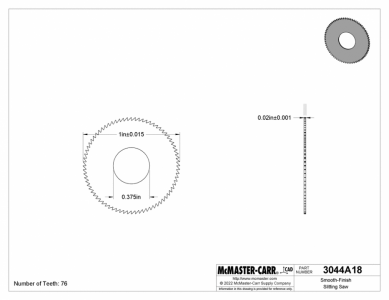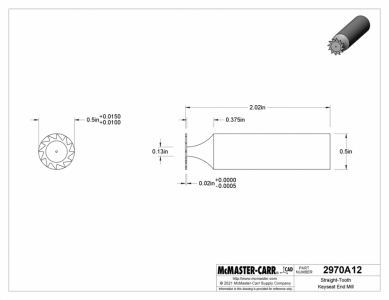I hear what you are saying, but my experience with this mill is that faster feed rates stall the motor. I don't think that 99 IPM in steel at 125 rpm for a 2.75" diameter HSS saw is remotely possible using my PM25. That being said, I would gladly be wrong.
I can attempt to estimate the feedrate on the PF and run a test with a different saw. If it works, I'll be delighted. Is 6 IPM worth trying? That's 1" in 10 seconds.
Slitting has always been dreadful on this machine. It could be I am doing it wrong, so I'm asking for some guidance.
Let's walk through both speed and feed. Earlier you said 150 RPM, just now you said 125RPM. The 2.75" cutter has a circumference of 8.63" or 0.72 feet. So 150 RPM is 108 SFPM, and 125 RPM is 90 SFPM. To be honest, I'd go a little slower if possible. But if you have a variable speed motor and no gear/belt reduction then spindle torque will be a problem...
Now the feed. At 150 RPM and 0.05 inches/minute, that is 0.00033" per revolution. Even if you only had three teeth, that is 0.0001" per tooth. With the 80 or so teeth that the cutter actually has you are talking a few millionths of an inch per tooth. I'm willing to bet It was rubbing, not cutting. That creates heat, and the rest follows naturally.
Did you see chips coming out of the cut? Or just shiny dust? They aren't going to be big chips, but they should be chips.
Due to runout a slitting saw isn't going to cut on every tooth. But it does need to CUT, not rub. I'm thinking you want to be feeding at least a couple thou per revolution, maybe as much as 10-20 thou per rev.
Getting back to the spindle speed and torque - I just looked up the manual for that machine. It has two mechanical speeds, with a 2:1 ratio. I assume you were on the low range. But even so, the torque is going to be pretty sad at such a low speed. That machine just isn't made to swing 2.75" diameter cutters. Both speeds are belt drive, so limited torque before the belt slips, even if the motor has good low speed torque.
How deep do you need to slot? Can you use a smaller diameter saw, perhaps something that is 1" or 1-1/2" diameter with a 1/2" arbor hole?
Like this maybe?

Or maybe something like this keyseating cutter? With a 1/2" cutting diameter you can spin it at 500 RPM for 65 SFPM surface speed. You'll have at least 5 times more force at the tip of the teeth because of the smaller diameter. Of course, it might not reach where you need to cut....




